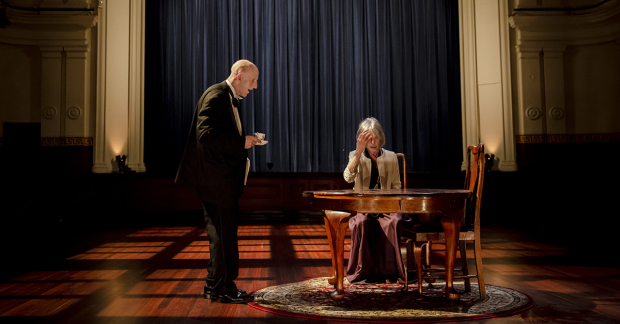I must come out immediately and say that anyone who suspends a chandelier in any auditorium during the Edinburgh Fringe, should be commended – it sits gloriously out of place and economically signposts the barrier between stage word and ours.
A mahogany round-table, two chairs, a glass of water, that chandelier and a wee round rug set the stage for an hour of slow disintegration. Or perhaps we begin with disintegration and proceed from there.
A bald head pokes out from behind the blacks around the stage. It’s David Woods, caked in pallid white makeup, bent, wearing a crumpled old oversized tux. Behind him, upstage, is the other half of Ridiculusmus, Jon Haynes, in grey wig, a white cardie and long pearl necklaces, and a sort of Victorian take on a skirt. These gathered signs of age take an age to cross to centre, while a clock ticks.
This entry is a chapter. For the lady (Vi) to reach her seat, perched on this shaky gentleman’s arm, takes ten or so minutes and during every one of their steps and moves I hold onto my chair, hoping they make it. There is a delight in theatre which offers nothing more than this. A clarity of intention.
Once they have come forward to the table a kind of Thank You speech prevails
‘We must thank the caterers’ Vi says. And we all laugh, we laugh because it is kind of unbelievable there were any caterers, ever. Unless we are at a funeral and the woman isn’t really here. Of course, since it’s theatre, the woman, the character, clearly played by a man, doesn’t exist. Our laughter is permitted by the contortions of theatre: we would never laugh at the plight of the old like this. Would we?
I am invested right from the start, I have confidence in these performers and the strange world they create. I watch every move and breath, tuned to subtleties. My focus moves from close examination of their hands, their necks, the sound of the clock ticking, the light changing. And all this in this seemingly empty space is filled with humour, satire, farce. And as a farce, it is funny and it is very sad – I am laughing as I reflect on the elderly people I know, so it is laughter and care and empathy and admiration I have for these two men on stage.
Then Arthur gets mentioned? Who is Arthur?
Does it matter who Arthur is? Arthur is apparently an old flame of Vi’s – we are not told much about it, but I feel no need to be told much about any of it. The absurdity of moments in the work only add to a sense of despair: Spitting on a sock which misses the sock and lands on the ground. Relentless taking of pills, and forgetting the day of the week, is it Wednesday or Friday? Who cares, just take all of them. Serving a cup of coffee on a white linen cloth – a cloth so crimped and manky. Unscrewing a table to find a pile of notes – notes which kind of relate to what we have seen, kind of don’t relate… but in all of this, what I see comes as a complete picture of time passing, people passing, characters passing, theatre genres passing, the passing of space even.
Die!Die!Die! Is a dark farce where much is made of seemingly nothing. It is a glorious conflagration of the confusions of dementia, warning us of our futures, of the loneliness and lack of care which awaits. It is unforgiving, sketching and destroying relationships in which whole lives have been invested, allowing us to grasp at disintegrating hints of story only to pull them away. There is no catharsis except our laughter: the sign of our inability to take these issues seriously enough.
Featured image (top) Ridiculusmus: Die! Die! Die! Old People Die! Photo by Bryony Jackson

